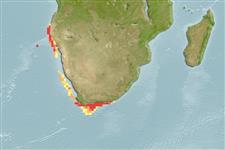Environment: milieu / climate zone / depth range / distribution range
Ekologi
marina; djupintervall ? - 450 m (Ref. 36731). Tropical
Southeast Atlantic: South Africa and Namibia.
Length at first maturity / Size / Vikt / Age
Maturity: Lm 9.5 range ? - ? cm
Max length : 17.0 cm SL hane/ej könsbestämd; (Ref. 36731)
Short description
Morfologi | Morfometri
Diagnosis: It hardly differs from the European anchovy (Engraulis encrasicolus); of other anchovies in southern and eastern African waters, species of Stolephorus have 3 to 7 sharp needle-like scutes along the belly, while species of Thryssa have compressed bodies and a keel of scutes along the belly (Ref. 189).
Pelagic in coastal waters, but down to a depth of about 400 m (Ref. 30573). It feeds on planktonic organisms (Ref. 30573). Larvae and juveniles were observed to be selective, raptorial carnivores and switched to non-selective filter feeding omnivory when adults. Caught with purse seines in South Africa and Namibia (Ref. 80687).
Life cycle and mating behavior
Könsmognad | Reproduktion | Lek | Ägg | Fecundity | Larver
Bianchi, G., K.E. Carpenter, J.-P. Roux, F.J. Molloy, D. Boyer and H.J. Boyer, 1999. FAO species identification guide for fishery purposes. Field guide to the living marine resources of Namibia. FAO, Rome. 265 p. (Ref. 36731)
IUCN Red List Status (Ref. 130435)
Threat to humans
Harmless
Human uses
Fiskeri:
Ytterligare information
Age/SizeTillväxtLength-weightLength-lengthLength-frequenciesMorfometriMorfologiLarverLarvdynamikRekryteringAbundansBRUVS
referenserVattenbrukVattenbruksprofilAvelslinjerGenetikElectrophoresesÄrftlighetSjukdomarBehandlingNutrientsMass conversion
MedarbetareBilderStamps, Coins Misc.LjudCiguateraHastighetSimsättGälytaOtolithsHjärnstorlekSyn
Verktyg
Special reports
Download XML
Internet-källor
Estimates based on models
Preferred temperature (Ref.
123201): 10.2 - 16.7, mean 13.7 °C (based on 40 cells).
Phylogenetic diversity index (Ref.
82804): PD
50 = 0.5020 [Uniqueness, from 0.5 = low to 2.0 = high].
Bayesian length-weight: a=0.00457 (0.00213 - 0.00980), b=3.12 (2.95 - 3.29), in cm total length, based on LWR estimates for this Genus-body shape (Ref.
93245).
Trofisk nivå (Ref.
69278): 3.0 ±0.1 se; based on size and trophs of closest relatives
Generation time: 1.2 ( na - na) years. Estimated as median ln(3)/K based on 1
growth studies.
Resiliens (Ref.
120179): Hög, lägsta populationsfördubblingstid mindre än 15 månader (Preliminary K or Fecundity.).
Prior r = 0.47, 95% CL = 0.31 - 0.71, Based on 1 stock assessment.
Fishing Vulnerability (Ref.
59153): Low vulnerability (11 of 100).
Climate Vulnerability (Ref.
125649): Low to moderate vulnerability (26 of 100).
Nutrients (Ref.
124155): Calcium = 347 [143, 896] mg/100g; Iron = 1.54 [0.71, 3.72] mg/100g; Protein = 17.9 [16.6, 19.3] %; Omega3 = 0.625 [0.326, 1.241] g/100g; Selenium = 50.5 [20.5, 129.2] μg/100g; VitaminA = 19.5 [4.1, 89.8] μg/100g; Zinc = 1.66 [0.99, 2.78] mg/100g (wet weight);
